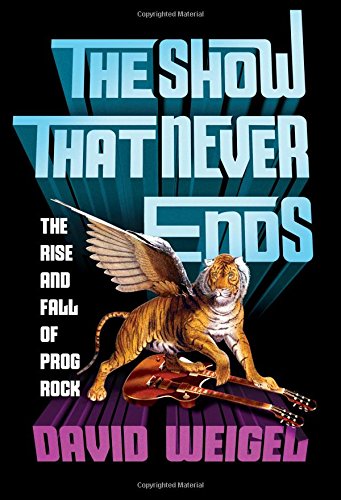Several years back, Dave Weigel wrote a series of articles chronicling the rise and fall of Prog Rock. Today, his new book is being published:
The fact that I linked to all five parts of his 2012 series is probably enough of a clue that I’m a fan of the genre and will be purchasing my own copy of the book. Here’s some of the blurb from the Amazon.ca page (Click on the image above to go to the Amazon.ca site):
The Show That Never Ends is the definitive story of the extraordinary rise and fall of progressive (“prog”) rock. Epitomized by such classic, chart-topping bands as Yes, Genesis, Pink Floyd, Jethro Tull, and Emerson Lake & Palmer, along with such successors as Rush, Marillion, Asia, Styx, and Porcupine Tree, prog sold hundreds of millions of records. It brought into the mainstream concept albums, spaced-out cover art, crazy time signatures, multitrack recording, and stagecraft so bombastic it was spoofed in the classic movie This Is Spinal Tap.
With a vast knowledge of what Rolling Stone has called “the deliciously decadent genre that the punks failed to kill,” access to key people who made the music, and the passion of a true enthusiast, Washington Post national reporter David Weigel tells the story of prog in all its pomp, creativity, and excess.
Weigel explains exactly what was “progressive” about prog rock and how its complexity and experimentalism arose from such precursors as the Beach Boys’ Pet Sounds and the Beatles’ Sgt. Pepper. He traces prog’s popularity from the massive success of Procol Harum’s “Whiter Shade of Pale” and the Moody Blues’ “Nights in White Satin” in 1967. He reveals how prog’s best-selling, epochal albums were made, including The Dark Side of the Moon, Thick as a Brick, and Tubular Bells. And he explores the rise of new instruments into the prog mix, such as the synthesizer, flute, mellotron, and—famously—the double-neck guitar.
If this clip of Yes performing “Roundabout” doesn’t immediately suggest Spinal Tap, I can only assume you’ve never seen the movie:
But not everyone of my generation was a fan of prog: here’s James Lileks summing up what he thought of the age of musical excess:
It’s obvious from Note One that everyone involved in the effort had so much THC in their system you could dry-cure their phlegm and get a buzz off the resin, but instead of having the loose happy ho-di-hi-dee-ho cheer of a Cab Calloway reefer number, the songs are soaked with Art and Importance and Meaning. You can imagine the band members sitting down to hash out (sorry) the overarching themes of the album, how it should like start with Total Chaos man because those are the times in which we live with like war from the sky, okay, and then we’ll have flutes because flutes are peaceful like doves and my old lady can play that part because she like studied flute, man, in high school. The lyrics are all the same: AND THE KING OF QUEENS SAID TO THE EARTH THE HEIROPHANT SHALL NOW GIVE BIRTH / THE HOODED PRIESTS IN CHAMBERED LAIRS LEERED DOWN UPON THE LADIES FAIR / NEWWWW DAAAAY DAWNNNING!





It is certainly true that prog rock groups could really go overboard with the lyrics; but the best of their material was the music. Going through the albums of Yes, Jon Anderson, and ABWH, as I have recently, one wonders how human beings can produce such complex and glorious sounds. Of course my theory is that they are agents of divinity, as were the Irish group The Bothy Band. 🙂
On a more down to earth note, it is truly astounding how the prog rock, psychedelic rock, the Beatles (a genre of their own) evolved so quickly from the mid-60s to the mid-70s.
Comment by steve muhlberger — June 13, 2017 @ 19:55